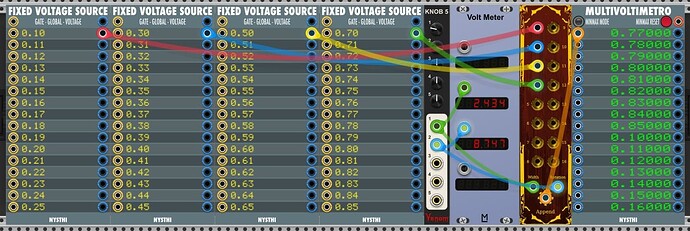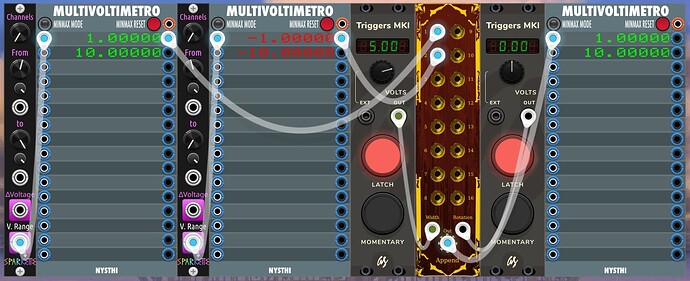I spent a few days really workshopping my manual, and hopefully I was able to get things across a lot more clearly:
Many modules are focused around seedable RNG, and/or routing polyphonic signals in useful ways such as shuffling, sorting, joining, or selecting subsets of them.
Spellbook (dev log) is a sequencer which uses a plaintext, “tracker like” notation, specifically created for a modular environment, and designed to be easily written, edited, and copy & pasted.
Mostly these modules are useful for routing signals and/or working with control voltages, as opposed to generating audio, but most do have the option to run at audio rate if they normally don’t (for mad science purposes).
Where to Get It:
- Download from the VCV Rack Library plugin page (recommended)
- Or, check Releases to install the latest release or to install the latest preview
The Modules
The modules might look a little intimidating, because there no knobs, only jacks. Everything is controlled via CV inputs. But don’t worry, they’re all very small, focused modules that will make sense once you use them.
-
Calendar - Output LFO-like signals based on local time and day, creating rising sawtooths synced with seconds, minutes, hours, days, through to years.
-
Sight - A scope where time slows down over the width of the scope, letting you see a signal over different time scales simultaneously.
-
Seed - Get 16 random numbers, with an option to provide an RNG seed.
-
Shuffle - Randomly re-order the channels of a polyphonic signal, with an option to provide an RNG seed.
-
Ouroboros - Step through the channels of a polyphonic signal as a sequence. Try using Seed as your sequence source! Maybe Shuffle it every two bars?
-
Append - Combine the channels of up to 16 mono or polyphonic cables (i.e. append the multiple lists together into one big list; up to a total internal buffer of 256 channels), then output a 1 to 16 channel subset of them, with CV controls for width and starting point.
-
Stats - Get statistical measures like mean, median, mode, product, etc. of the channels of a polyphonic signal, inspired by spreadsheet functions like AVERAGE(), MEDIAN(), MODE(), UNIQUE(), etc.
-
Sort - Sort and select channels from a polyphonic cable using other polyphonic CV inputs, inspired by the spreadsheet functions RANK() and FILTER().
-
Spine - A few static CV constants/offsets I use a lot like +/-1, +/-5, +/-10, multiply by -1, etc.
-
Spellbook - Plain text “musical markup” sequencing of CVs/pitches, with a broad variety of accepted formats for however you want to write your sequences; such as pitch names, MIDI note numbers, semitones, Hertz, etc. Write out sequences in rows and columns like a spreadsheet!








